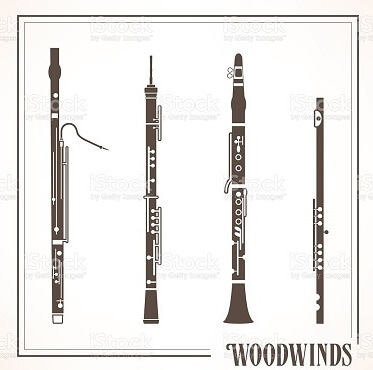Woodwind Instruments
 Woodwind, any of a group of wind musical instruments, composed of the flutes and reed pipes (i.e., clarinet, oboe, bassoon, and saxophone). Both groups were traditionally made of wood, but now they may also be constructed of metal.
Woodwind, any of a group of wind musical instruments, composed of the flutes and reed pipes (i.e., clarinet, oboe, bassoon, and saxophone). Both groups were traditionally made of wood, but now they may also be constructed of metal.
Woodwinds are distinguished from other wind instruments by the manner in which the sound is produced. Unlike the trumpets or other instruments of the brass family, in which the airstream passes through the player’s vibrating lips directly into the air column, the flutes are sounded by directing a narrow stream of air against the edge of a hole in a cylindrical tube. With the reed pipes (e.g., clarinets and saxophones), a thin strip of flexible material, such as cane or metal, is placed against the opening of the mouthpiece, forcing the airstream to pass through the reed before it reaches the column of air that is to vibrate. In double-reed instruments (oboes and bassoons), two thicknesses of reeds are used. The woodwind section of a band or orchestra usually consists of three flutes, one piccolo, three oboes, one English horn, three clarinets, one bass clarinet, three bassoons, and one contrabassoon.
There are various types of woodwind instruments ranging in shape, material and size. What is common is that sound is produced by vibration of something other than lips. Recorders that most people have played in elementary and junior high school are also members of woodwind instruments. Another characteristic different from brass instruments is that they change the pitch by closing holes. Originally like a recorder, a hole called sound hole was directly closed with a finger. With the evolution of musical instruments, it became possible to use "keys" like those on flutes and saxophones to close holes and play wider ranges.
It is roughly classified into three according to how to make sound.
- Flutes
- Single Reed
- Double Reed
Flutes
Flute, French flûte, German Flöte, wind instrument in which the sound is produced by a stream of air directed against a sharp edge, upon which the air breaks up into eddies that alternate regularly above and below the edge, setting into vibration the air enclosed in the flute. In vertical, end-vibrated flutes—such as the Balkan kaval, the Arabic nāy, and panpipes—the player holds the pipe end to his mouth, directing his breath against the opposite edge. In China, South America, Africa, and elsewhere, a notch may be cut in the edge to facilitate sound generation (notched flutes). Vertical nose flutes are also found, especially in Oceania. In transverse, or cross, flutes (i.e., horizontally held and side blown), the stream of breath strikes the opposite rim of a lateral mouth hole. Vertical flutes such as the recorder, in which an internal flue or duct directs the air against a hole cut in the side of the instrument, are known as fipple, or whistle, flutes. Flutes are typically tubular but may also be globular, as with the ocarina and primitive gourd flutes. If a tubular flute is stopped at the lower end, its pitch is an octave lower than that of a comparable open flute.
List of Flute Instruments
Single Reed
Single reed instruments are woodwind instruments that use a single reed to produce sound. Very much in contrast to double reed instruments, which use two reeds to produce sound, single reed instruments only have one reed and require a mouthpiece to produce sound. This is why a mouthpiece is an essential part of single reed instruments and isn’t necessary for instruments in the double reed family. Sound on woodwind instruments, both those with single and double reeds, comes from the vibrating column of air inside the instrument. The reed in single reed instruments is clamped to the mouthpiece so that only a very narrow opening remains between the tip of the reed and the mouthpiece. When the player closes their lips around the mouthpiece and blows, a tone is created as the reed vibrates against the mouthpiece. On a very basic level the reed and the mouthpiece work together as valves that open and close. As the air presses the reed against the opening of the mouthpiece, the stream of air is blocked. Because the reed is elastic, it immediately swings back and the air streams in again, pressing the reed against the opening.
List of Single Reed Instruments
Double Reed
Double reed instruments feature reeds with two pieces of cane that vibrate against each other when a musician blows against them. As you’ve probably guessed, single reed instruments use only one piece of cane to produce sound. The term “double reed” also refers to collectively to the class of instruments which use double reeds. A double reed instrument will bring a charmingly distinct sound to any ensemble or orchestra, but the exact sound will vary depending on the material used during construction. Double reed instruments made mostly from plastic are durable and easier to care for, making them an ideal choice for younger children or for those who may be more on the careless side, but don’t produce as warm a sound as double reed instruments constructed from wood. Although wooden double reed instruments produce a sound that’s more representative of the instrument, they require more maintenance than their plastic counterparts. In order to keep your double reed instrument in tip-top shape, proper care and maintenance is required.
List of Double Reed Instruments